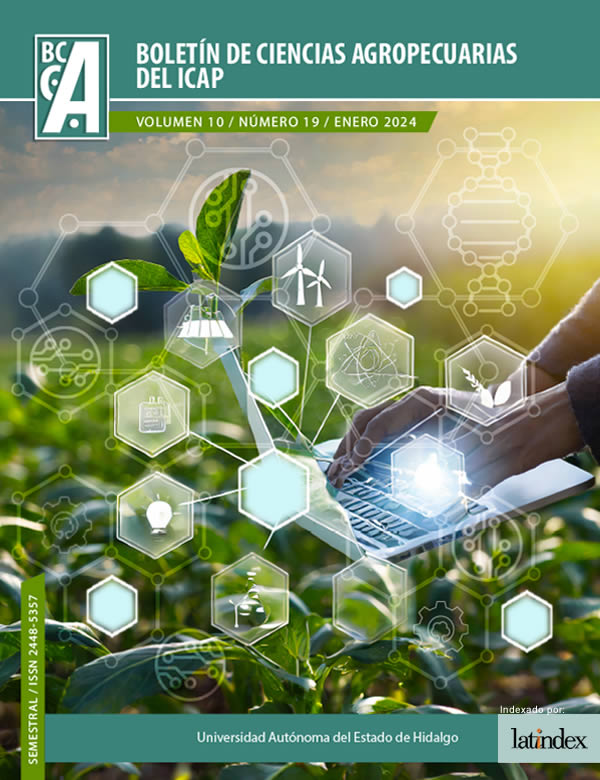Potential use of black soldier fly Hermetia illucens L. for bioconversion of organic wastes and their use in agriculture
Abstract
The lack of separation and treatment of organic waste in Mexico and the world is a problem that affects the environment. The use of Hermetia illucens black soldier fly larvae is a sustainable alternative for the bioconversion of organic waste. The purpose of this article is to provide information about the potential of black soldier fly larvae in the bioconversion of different types and amounts of organic wastes, generating products such as the waste excreted by the larvae, in English known as “frass”, which has a composition similar to an immature compost, which can be used as fertilizer for agricultural purposes for its content of N, P, K. This topic requires more research on the physicochemical properties, maturation and pre- and post-treatments of the compost produced by larvae for their suitable use in agriculture.
Downloads
References
Basri NEA, Azman NA, Ahmad IK, Suja F, Jalil NAA, Amrul NF. Potential applications of frass derived from black soldier fly larvae treatment of food waste: A review. Foods. 2022;11(17):26-64
Lopes IG, Yong JWH, Lalander C. Frass derived from black soldier fly larvae treatment of biodegradable wastes. A critical review and future perspectives. Waste Manag. 2022; 142:65–76.
Pasos M. Caracterización y gestión de los residuos orgánicos en América del Norte [Internet]. Comisión para la Cooperación Ambiental. Commission for Environmental Cooperation. 2018
Anda-Trasviña, A., García-Galindo, E., Peña-Castañón A., Seminario-Peña, J., Nieto-Garibay, A. Residuos orgánicos ¿Basura o Recurso? 2021; 7(3):19–42.
Čičková H, Newton GL, Lacy RC, Kozánek M. The use of fly larvae for organic waste treatment. Waste Manag. 2015; 35:68–80.
Gold M, Tomberlin JK, Diener S, Zurbrügg C, Mathys A. Decomposition of biowaste macronutrients, microbes, and chemicals in black soldier fly larval treatment: A review. Waste Manag. 2018;82: 302–18.
Barragan-Fonseca KB, Dicke M, van Loon JJA. Nutritional value of the black soldier fly (Hermetia illucens L.) and its suitability as animal feed – a review. J Insects Food Feed. 2017; 3(2):105–20
Beesigamukama D, Mochoge B, Korir NK, Fiaboe KKM, Nakimbugwe D, Khamis FM, et al. Exploring black soldier fly frass as novel fertilizer for improved growth, yield, and nitrogen use efficiency of maize under field conditions. Front Plant Sci. 2020;11.
Smetana S, Spykman R, Heinz V. Environmental aspects of insect mass production. J Insects Food Feed. 2021;7(5):553–71.
Surendra KC, Tomberlin JK, van Huis A, Cammack JA, Heckmann L-HL, Khanal SK. Rethinking organic wastes bioconversion: Evaluating the potential of the black soldier fly (Hermetia illucens (L.)) (Diptera: Stratiomyidae) (BSF). Waste Manag .2020; 117:58–80.
Vanessa M, Olvera O, Fernando J, Trejo G, Gutiérrez C. Mosca soldado negra: Novedades científicas. 2022;73(3):52–59.
Domenico, C., Devic, E., & Subamia, W. Technical handbook of domestication and production of diptera Black Soldier Fly (BSF) Hermetia illucens, Stratiomydae. Kencana Bogor. IRD Edition; 2014.
Dortmans B.M.A., Egger J., Diener S., Zurbrügg C. Black Soldier Fly Biowaste Processing - A Step-by-Step Guide, 2nd Edition Eawag: Swiss Federal Institute of Aquatic Science and Technology, Dübendorf, Switzerland. 2021
Quilliam RS, Nuku-Adeku C, Maquart P, Little D, Newton R, Murray F. Integrating insect frass biofertilisers into sustainable peri-urban agro-food systems. J Insects Food Feed. 2020;6(3):315–22.
Lalander C, Ermolaev E, Wiklicky V, Vinnerås B. Process efficiency and ventilation requirement in black soldier fly larvae composting of substrates with high water content. Sci Total Environ. 2020;7 29(138968):138968
Rehman K ur, Ur Rehman R, Somroo AA, Cai M, Zheng L, Xiao X, et al. Enhanced bioconversion of dairy and chicken manure by the interaction of exogenous bacteria and black soldier fly larvae. J Environ Manage. 2019; 237:75–83.
Parra Paz AS, Carrejo NS, Gómez Rodríguez CH. Effects of larval density and feeding rates on the bioconversion of vegetable waste using black soldier fly larvae Hermetia illucens (L.), (Diptera: Stratiomyidae). Waste Biomass Valorization. 2015; 6(6):59–65.
Meneguz M, Schiavone A, Gai F, Dama A, Lussiana C, Renna M, et al. Effect of rearing substrate on growth performance, waste reduction efficiency and chemical composition of black soldier fly (Hermetia illucens) larvae. J Sci Food Agric. 2018; 98(15):5776–84.
Attiogbe FK, Ayim NYK, Martey J. Effectiveness of black soldier fly larvae in composting mercury contaminated organic waste. Scientific African. 2019;6(e00205): e00205.
Song S, Ee AWL, Tan JKN, Cheong JC, Chiam Z, Arora S, et al. Upcycling food waste using black soldier fly larvae: Effects of further composting on frass quality, fertilizing effect and its global warming potential. J Clean Prod. 2021; 288(125664):125664
Chiam Z, Lee JTE, Tan JKN, Song S, Arora S, Tong YW, et al. Evaluating the potential of okara-derived black soldier fly larval frass as a soil amendment. J Environ Manage. 2021; 286(112163):112163
Azim K, Soudi B, Boukhari S, Perissol C, Roussos S, Thami Alami I. Composting parameters and compost quality: a literature review. Org Agric. 2018;8(2):141–58.
Guo R, Li G, Jiang T, Schuchardt F, Chen T, Zhao Y, et al. Effect of aeration rate, C/N ratio and moisture content on the stability and maturity of compost. Bioresour Technol. 2012; 112:171–8.
Copyright (c) 2024 Diana Aydee Hernández-Trejo , Eliazar Aquino, Margarita Islas-Pelcastre, Mariana Saucedo-García , Alfredo Alfredo Madariaga-Navarrete, Jaime Pacheco-Trejo

This work is licensed under a Creative Commons Attribution-NonCommercial-NoDerivatives 4.0 International License.










